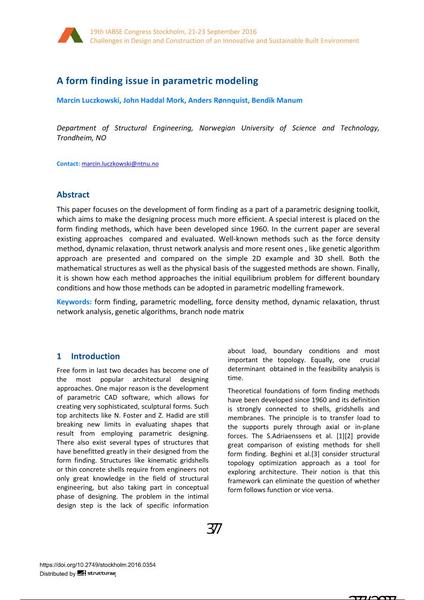A form finding issue in parametric modeling

|
|
|||||||||||
Bibliografische Angaben
| Autor(en): |
Marcin Luczkowski
(Department of Structural Engineering, Norwegian University of Science and Technology, Trondheim, NO)
John Haddal Mork (Department of Structural Engineering, Norwegian University of Science and Technology, Trondheim, NO) Anders Rønnquist (Department of Structural Engineering, Norwegian University of Science and Technology, Trondheim, NO) Bendik Manum (Department of Structural Engineering, Norwegian University of Science and Technology, Trondheim, NO) |
||||
|---|---|---|---|---|---|
| Medium: | Tagungsbeitrag | ||||
| Sprache(n): | Englisch | ||||
| Tagung: | IABSE Congress: Challenges in Design and Construction of an Innovative and Sustainable Built Environment, Stockholm, Sweden, 21-23 September 2016 | ||||
| Veröffentlicht in: | IABSE Congress Stockholm, 2016 | ||||
|
|||||
| Seite(n): | 377-384 | ||||
| Anzahl der Seiten (im PDF): | 8 | ||||
| Jahr: | 2016 | ||||
| DOI: | 10.2749/stockholm.2016.0354 | ||||
| Abstrakt: |
This paper focuses on the development of form finding as a part of a parametric designing toolkit, which aims to make the designing process much more efficient. A special interest is placed on the form finding methods, which have been developed since 1960. In the current paper are several existing approaches compared and evaluated. Well-known methods such as the force density method, dynamic relaxation, thrust network analysis and more resent ones, like genetic algorithm approach are presented and compared on the simple 2D example and 3D shell. Both the mathematical structures as well as the physical basis of the suggested methods are shown. Finally, it is shown how each method approaches the initial equilibrium problem for different boundary conditions and how those methods can be adopted in parametric modelling framework. |
||||
| Stichwörter: |
Formgebung dynamische Relaxation
|
||||
